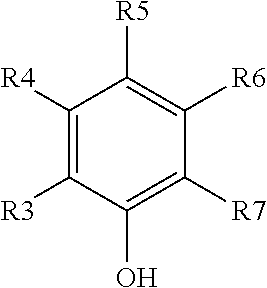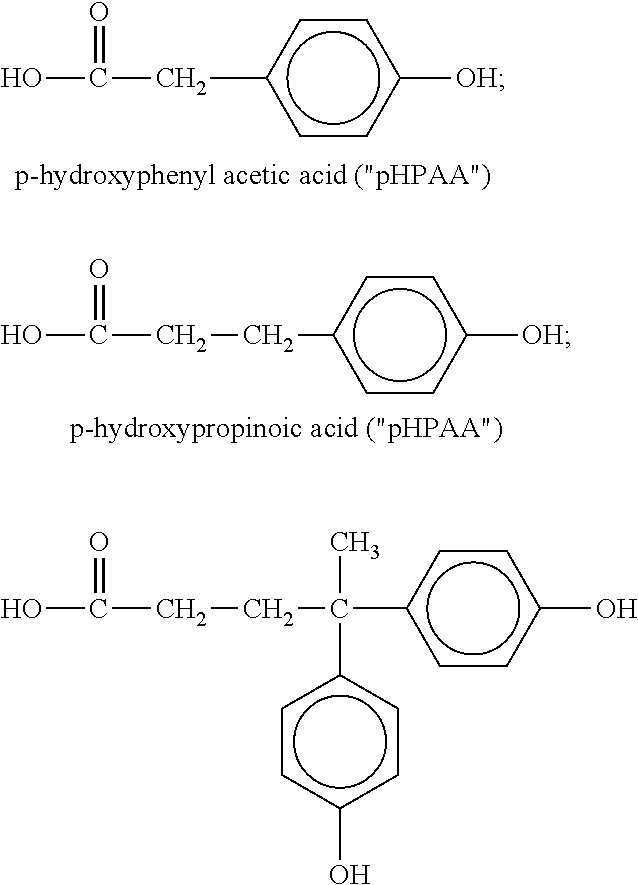Polyester Polymer Having Phenolic Functionality and Coating Compositions Formed Therefrom
a polymer and functional technology, applied in the field of polymer polymer and coating composition, can solve the problems of contaminating the packaged product, forming polyester-based coatings, and recycling of materials containing polyvinyl chloride or related halide-containing vinyl polymers
- Summary
- Abstract
- Description
- Claims
- Application Information
AI Technical Summary
Benefits of technology
Problems solved by technology
Method used
Image
Examples
examples
[0124]The invention is illustrated by the following examples. It is to be understood that the particular examples, materials, amounts, and procedures are to be interpreted broadly in accordance with the scope and spirit of the inventions as set forth herein. Unless otherwise indicated, all parts and percentages are by weight and all molecular weights are weight average molecular weight. Unless otherwise specified, all chemicals used are commercially available from, for example, Sigma-Aldrich, St. Louis, Mo.
examples 1 and 2
Cardanol Adducts
[0125]
TABLE 1Example 1Example 2Ingredient(wt-%)(wt-%)1Cardanol 1500 - 166.169.62Maleic anhydride18.517.03Hydroquinone mono methyl ether0.10.14Xylene5.28.15Xylene6.65.2
[0126]Adducts of cardanol and maleic anhydride were produced as follows. The list of ingredients used to produce the adducts of Examples 1 and 2 are provided in Table 1. The cardanol compound (i.e., ingredient 1) was the Cardanol 1500-1 product from Cardolite Corporation. For each of Examples 1 and 2, ingredients 1-4 of Table 1 were combined, and the adducts of cardanol and maleic anhydride were obtained by via an Adler-ene reaction by heating the resulting mixture at 180 to 200° C., under solvent reflux. Formation of the adduct was followed by monitoring the amount of unreacted maleic anhydride using gel permeation chromatography (“GPC”) analysis. The reaction was determined to be complete when the wt-% of maleic anhydride was less than 0.5%. The reaction time varied from about 4 to about 10 hours, dep...
examples 3 and 4
Cardanol-Containing, Phenolic-Functional Polyester
[0127]
TABLE 2Example 3Example 4Ingredients(wt-%)(wt-%)1Neopentyl glycol28192Ethylene glycol331-4,cyclohexane dimethanol114Benzylic alcohol25Isophthalic acid26206Terephthalic acid207Cardanol Adduct of Example 146258Dibutyl tin dilaurate (DBTL)0.080.08Total reactants, % in weight1001009Xylene9.510Solvesso 1009.319.4
[0128]In Examples 3 and 4, a phenolic-functional polyester was produced in which pendant phenolic groups were provided through incorporation of a cardanol / maleic anhydride adduct into the backbone of the polyester. The ingredients for producing the phenolic-functional polyesters of Examples 3 and 4 are provided in Table 2. Components 1 to 8 were reacted in a reactor under reflux conditions using components 9 and / or 10. The esterification reaction proceeded under reaction temperatures of about 190 to 210° C. until an acid value of less than 10 was observed. The final acid value for the polyester of Example 3 was 10 and the fi...
PUM
| Property | Measurement | Unit |
|---|---|---|
| weight percent | aaaaa | aaaaa |
| composition | aaaaa | aaaaa |
| nonvolatile weight | aaaaa | aaaaa |
Abstract
Description
Claims
Application Information
 Login to View More
Login to View More - R&D
- Intellectual Property
- Life Sciences
- Materials
- Tech Scout
- Unparalleled Data Quality
- Higher Quality Content
- 60% Fewer Hallucinations
Browse by: Latest US Patents, China's latest patents, Technical Efficacy Thesaurus, Application Domain, Technology Topic, Popular Technical Reports.
© 2025 PatSnap. All rights reserved.Legal|Privacy policy|Modern Slavery Act Transparency Statement|Sitemap|About US| Contact US: help@patsnap.com



